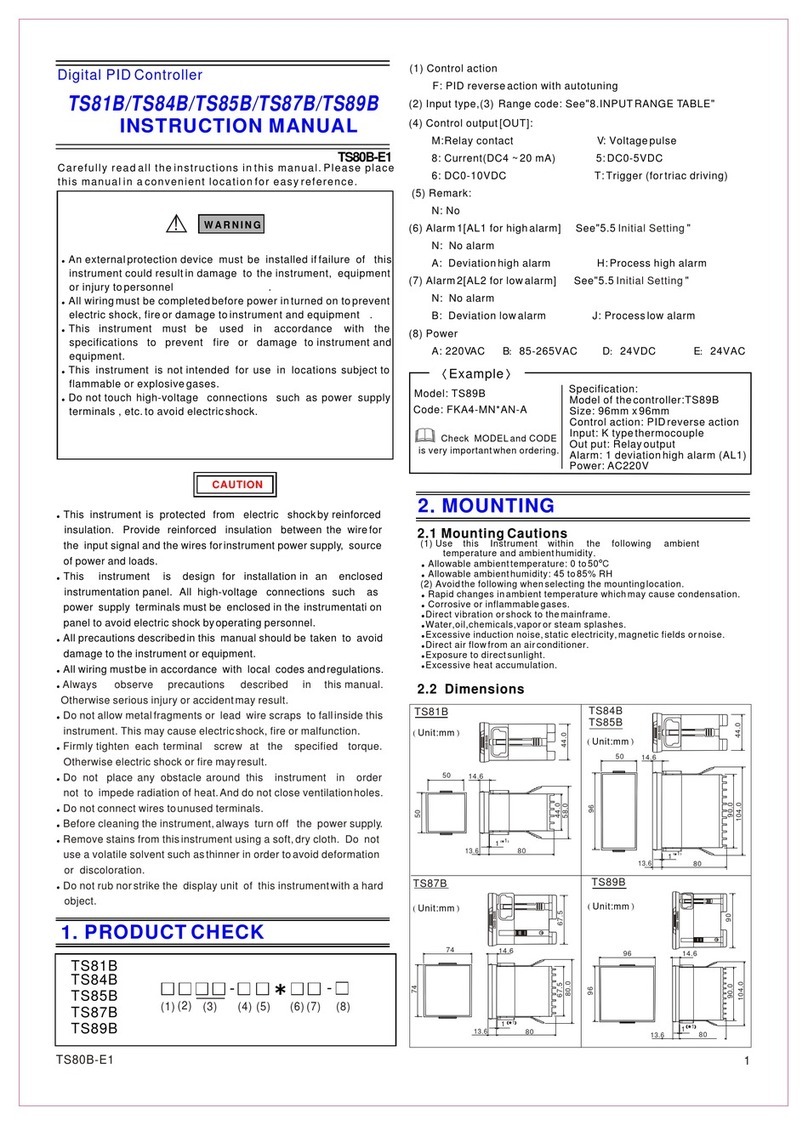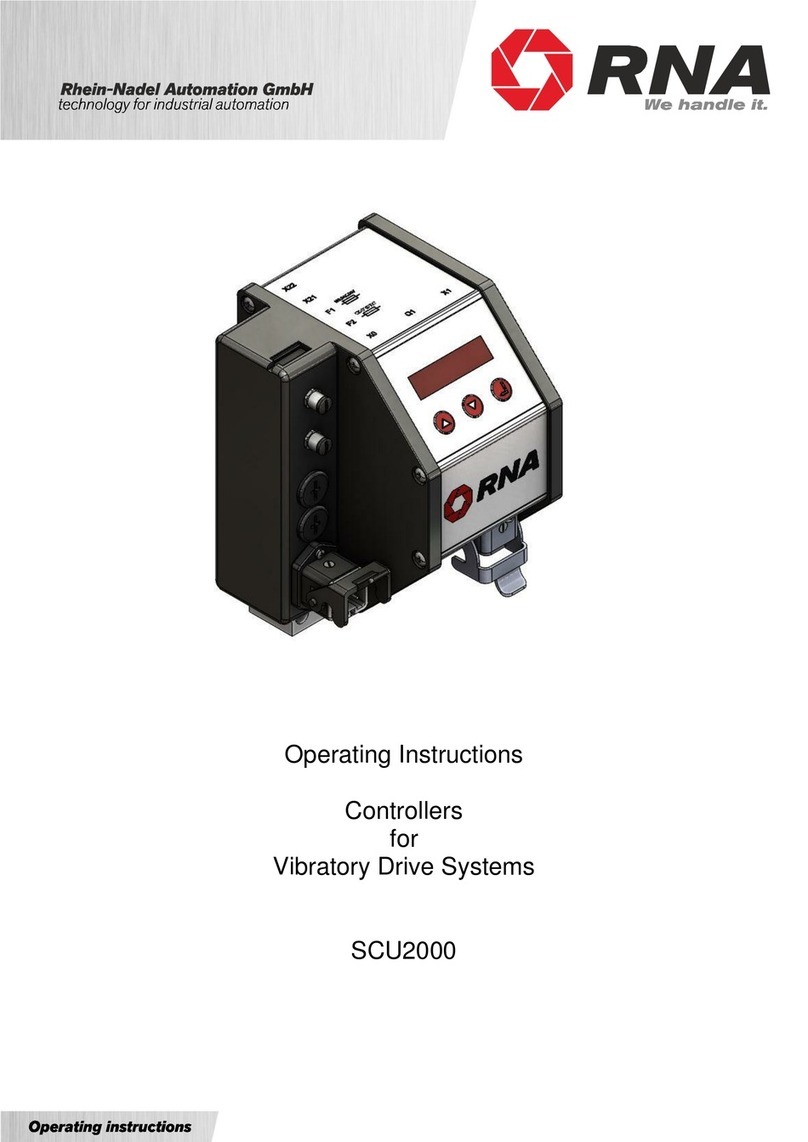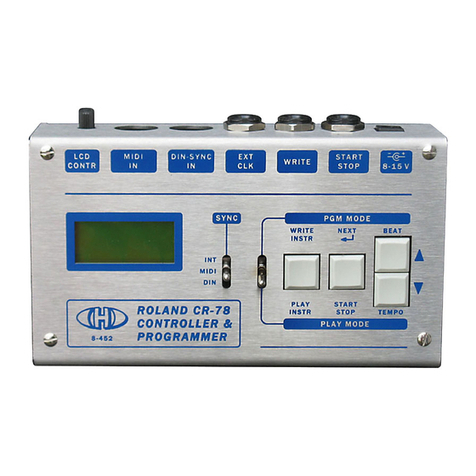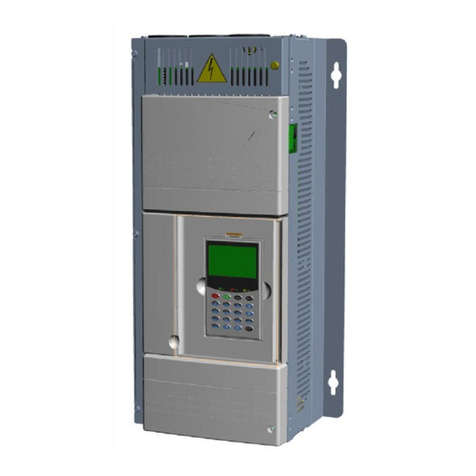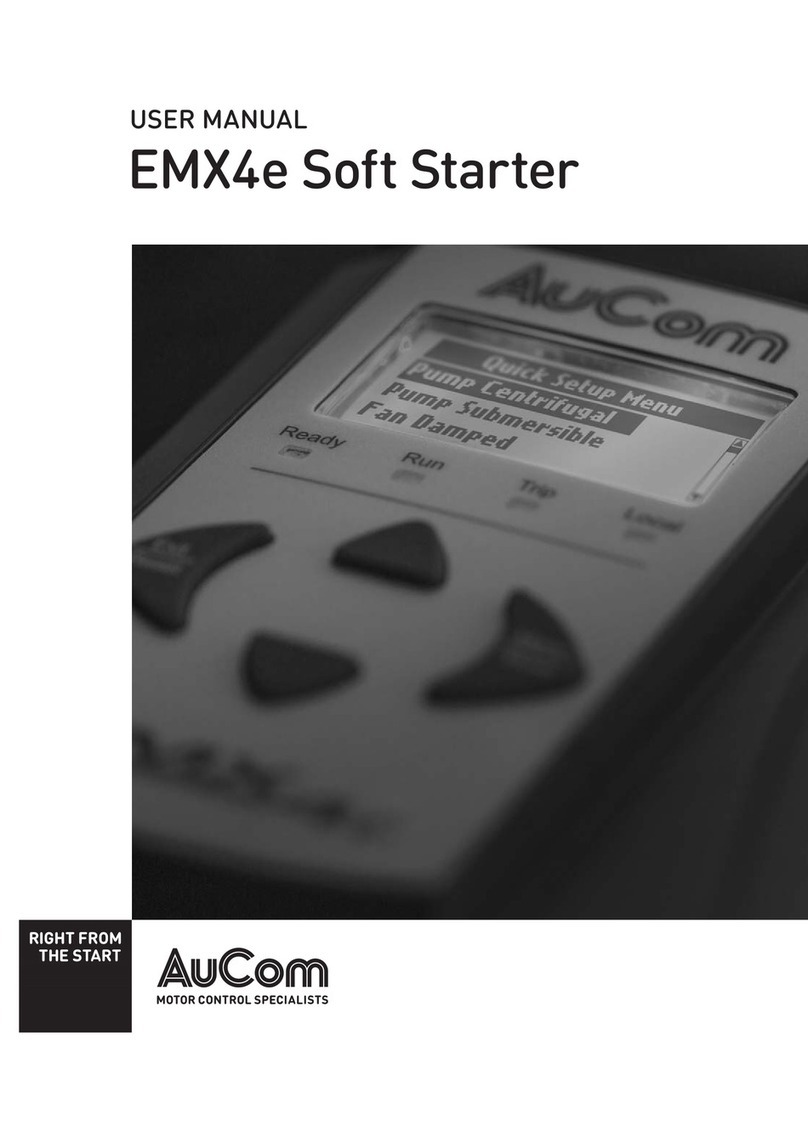MillipaK PMAC User manual


Document History
______________________________________________________________________________
MillipaK PMAC Controller Manual Page 2 26/04/06
Document History
Author Reviewer
Initials Date Initials Date Version Reason for Modification
PG 04 Jan 06 - - UK0157.04 Original.
PG 16 Feb 06 - - UK0157.05 Update
PG 05 Apr 06 - - UK0157.07 Removal of Walkie Functionality
PG 24 Apr 06 - - UK0157.08 Added proportional direction braking

Contents
______________________________________________________________________________
MillipaK PMAC Controller Manual Page 3 26/04/06
CONTENTS
Introduction.......................................................................................................................................5
Safety ................................................................................................................................................6
Installation.........................................................................................................................................7
MOUNTING......................................................................................................................................................................7
MILLIPAKPMAC POWER WIRING.................................................................................................................................8
MILLIPAKLIGHT WIRING EXAMPLE...............................................................................................................................9
Calibrator ........................................................................................................................................11
DRIVE HOURS COUNTER...............................................................................................................................................12
CALIBRATOR SECURITY LEVELS ..................................................................................................................................13
NAVIGATION .................................................................................................................................................................14
ADJUSTMENTS...............................................................................................................................................................15
STATUS AND TEST INFORMATION.................................................................................................................................16
Configuration..................................................................................................................................17
SYSTEM CONFIGURATION.............................................................................................................................................17
System Voltage.........................................................................................................................................................18
System I/O Configuration........................................................................................................................................19
Contactor chopping.................................................................................................................................................22
Accelerator Full /Zero Setting ................................................................................................................................23
Motor Poles.............................................................................................................................................................24
Maximum Motor RPM.............................................................................................................................................25
Phase Adjustment ....................................................................................................................................................26
PERFORMANCE..............................................................................................................................................................27
Control Mode...........................................................................................................................................................27
Speed Control PI Gains...........................................................................................................................................28
Acceleration Delay..................................................................................................................................................30
Deceleration Delay..................................................................................................................................................30
Direction Change Deceleration Delay ...................................................................................................................30
Neutral Deceleration Delay....................................................................................................................................30
Regen Braking.........................................................................................................................................................31
Braking Levels.........................................................................................................................................................31
Footbraking.............................................................................................................................................................32
Creep Speed.............................................................................................................................................................34
Maximum Speed.......................................................................................................................................................35
Accelerator Characteristics ....................................................................................................................................36
Features...........................................................................................................................................37
STANDARD CONTROLLER FEATURES............................................................................................................................37
Power Steer..............................................................................................................................................................38
Seat Switch...............................................................................................................................................................39
Handbrake Switch ...................................................................................................................................................40
Cutback speeds........................................................................................................................................................41
Reverse Speed..........................................................................................................................................................42
Pump Contactor.......................................................................................................................................................43
External LED Drive.................................................................................................................................................44
Traction Motor Over-Temperature Input...............................................................................................................45
Drive Hours Meter ..................................................................................................................................................46
Personality Checksum.............................................................................................................................................47
Line Contactor Drop out.........................................................................................................................................48

Contents
______________________________________________________________________________
MillipaK PMAC Controller Manual Page 4 26/04/06
Alarm Buzzer ...........................................................................................................................................................49
Electric Outboard Drive and Low Battery Warning..............................................................................................50
Temporary Current Boost .......................................................................................................................................51
SAFETY FEATURES........................................................................................................................................................52
Start Up Sequence...................................................................................................................................................52
FS1 Recycle .............................................................................................................................................................53
SRO (Static return to off) ........................................................................................................................................54
Anti-Rollback...........................................................................................................................................................55
Anti-Rolloff ..............................................................................................................................................................56
Idle Fault .................................................................................................................................................................57
Motor Stall Protection.............................................................................................................................................58
Fail-safe...................................................................................................................................................................59
Controller Protection Features........................................................................................................60
TEMPERATURE MONITORING........................................................................................................................................60
Maximum Temperature Logging.............................................................................................................................60
SAFE OPERATING AREA (SOA) ....................................................................................................................................62
UNDER-VOLTAGE AND OVER-VOLTAGE PROTECTION...................................................................................................63
Commissioning Checklist...............................................................................................................66
PERSONALITY RECORD .................................................................................................................................................67
Fault Finding...................................................................................................................................69
FAULT CLEARANCE.......................................................................................................................................................70
FAULT REPORTING FORM .............................................................................................................................................71
SOFTWARE VERSION AND SERIAL NUMBER INDICATION .............................................................................................72
Specifications..................................................................................................................................73
POWER CONFIGURATIONS.............................................................................................................................................73
EMC STANDARDS .........................................................................................................................................................73
SOCKET BPROTECTION.................................................................................................................................................73
CONTACTOR DRIVE RATINGS ........................................................................................................................................73
ANALOGUE INPUT IMPEDANCE.....................................................................................................................................73
DIGITAL INPUT IMPEDANCE..........................................................................................................................................73
EMC Guidelines..............................................................................................................................74

Introduction
______________________________________________________________________________
MillipaK PMAC Controller Manual Page 5 26/04/06
Introduction
The MillipaK PMAC (Permanent Magnet AC) range of controllers provides a new range of power
frames for 24V-36V, 250A and 48V, 200A in small highly efficient packages. This is achieved
using a Sevcon patented power switching scheme and radical new construction techniques, which
enable large powers to be incorporated into very small packages.
The MillipaK provides a completely sealed (IP66) unit containing both power and logic circuitry,
as well as all suppression components.
MillipaK supports Sevcon’s existing MOS90 calibrator for adjustment of vehicle performance
characteristics.
Controllers are FLASH microprocessor based enabling field re-programming for new features and
have numerous user set-up options. The MillipaK uses high frequency (silent) MOSFET power
switching technology, to control a 3-phase power frame bridge. Armature current is monitored.
Motor feedback is necessary in the form of position sensors. Controllers have been designed to
satisfy the requirements of the relevant UL and EC standards.

Safety
______________________________________________________________________________
MillipaK PMAC Controller Manual Page 6 26/04/06
Safety
The MillipaK controller contains a triple fail-safe system to give a high level of safety. If the
diagnostic LED is not illuminated or flashes, the safety circuit may have tripped and the motor
may not drive.
The controller must be used with a line contactor as indicated in the wiring diagrams.
As blow-out magnets are fitted to contactors (except 24V) ensure that no magnetic particles can
accumulate in the contact gaps and cause malfunction. Ensure that contactors are wired with the
correct polarity to their power terminals as indicated by the + sign on the top moulding.
The MillipaK controller may be used with suitable onboard chargers, as supplied by Sevcon.
There are several software features which are intended to prevent inadvertent or unexpected motor
movement – Accelerator power up fault and sequence checking. Some of these features cannot be
disabled and the appropriate signals must be supplied to the controller before drive will be
allowed.

Installation Mounting
______________________________________________________________________________
MillipaK PMAC Controller Manual Page 7 26/04/06
Installation
The small footprint of the MillipaK controller gives maximum flexibility to the user for mounting
options. The following section gives details of certain criteria that should be considered when
situating the controller on a vehicle.
Mounting
The MillipaK PMAC unit provides 4 x M6 clearance holes for mounting. The controller should be
mounted onto a metal base plate, as large as possible to provide heat-sinking. The surface finish
should be flat, clean and burr free and thermal compound should be applied to the controller base
before fitting.
Figure 1: MillipaK PMAC Dimensions
Maximum terminal torque: M8 terminals – 10NM
M6 terminals – 7NM

Installation Wiring/Power
______________________________________________________________________________
MillipaK PMAC Controller Manual Page 8 26/04/06
MillipaK PMAC Power Wiring
M1
M2
M3
B+
B-
Fuse Line
Contactor
Battery
Supply
BPM Motor
Figure 2: MillipaK PMAC Power Wiring

Installation Wiring/Light
______________________________________________________________________________
MillipaK PMAC Controller Manual Page 9 26/04/06
MillipaK Light Wiring example
1
2
3
4
5
6
0V
+ 10.5V
Clock
Data
Connector A
1
2
3
4
5
6
7
8
9
10
11
12
13
14
15
16
17
18
19
20
Connector B
Fuse
Battery +ve Key-s w itch
Accel.
Pot.
Forward (Dig 1)
Reverse (Dig 2)
Battery -ve
Analogue Input 1
12V Output
CALIBRATOR
Sevcontrol
SEL
Analog
Calibrator Detect
Line Contactor*
Auxiliary Contactor*
Extra Suppression 1**
Extra Suppression 2**
Horn Suppression**
Battery +ve
Battery -ve
Extra Suppression 1 or 2
or Horn Suppression
External Contactor /
Horn
NOTES:
*Contactor Coil Suppression fitted internally.
**ExtraSuppression and Horn Suppression inputs to be used as shown below:
Encoder - RPS1
Encoder - RPS2
Encoder - RPS3
Encoder - 0V
Dig I/P 3
Dig I/P 4
Dig I/P 5
Dig I/P 6
Analogue Input 2
Figure 3: MillipaK Light Wiring

Installation Wiring/Light
______________________________________________________________________________
MillipaK PMAC Controller Manual Page 10 26/04/06
NOTES:
The line and auxiliary contactors are wired to B+, on the switched side of the key-switch.
Pin 12 is available for 100mA supply, typically used for (but not limited to) accelerator modules.
Pins 13,14 & 15 are general-purpose suppression connections and may be used to suppress spikes
generated by contactors opening / closing. The internal configuration is shown below:
Pin 16 is used to select FLASH memory program update mode and should normally be left
unconnected.

Calibrator Calibrator/General
______________________________________________________________________________
MillipaK PMAC Controller Manual Page 11 26/04/06
Calibrator
The Calibrator is a hand-held adjustment unit which can be used to configure and test the system.
The MillipaK is designed to work with the Calibrator currently in use with SEVCON's MOS90
system. See diagram below. The menu structure is shown in the Calibrator Map located near the
end of this manual.
CALIBRATOR
Sevcontrol
+
-
SELECT
i.8.8.8
Figure 4: MillipaK Calibrator

Calibrator Calibrator/ Drive Hours Counter
______________________________________________________________________________
MillipaK PMAC Controller Manual Page 12 26/04/06
Drive Hours Counter
When the Calibrator is first plugged into the unit after power up, the Calibrator shows the Drive
Hours Counter. Refer to the Drive Hours Counter section for more information on this function.
With no buttons pressed, the number displayed shows the number of minutes (accurate to 0.5
minutes). Pressing the '-' button displays the number of hours under 1000 and pressing the '-'
button displays the number of 1000 x hours.
For example, if the hours counter was 12, 345 hours, 13 minutes and 40 seconds, with no buttons
pressed, the display would show 13.5. Minutes are only shown to the nearest 0.5 minutes. If the '-'
button was pressed, the display would show 345 (number of hours under 1000) and if the '+'
button was pressed, the display would show 12 (number of 1000 x hours).
This is the only time that the hours counter can be viewed. Once the Select button has been
pressed to enter the normal calibrator menu structure, it is not possible to return to this point. To
view the hours counter again, you must recycle the Keyswitch.
This is also the point at which you can enter a password to enable different levels of access to
personalities. Refer to the section below on Calibrator Security Levels for more details.

Calibrator Calibrator/Security Levels
______________________________________________________________________________
MillipaK PMAC Controller Manual Page 13 26/04/06
Calibrator Security Levels
Which personalities and status items which can be viewed on the Calibrator is restricted using
passwords. There are three levels of Calibrator access. These are shown in Table 1.
Access Level Text Password Description
Service Ser - Default. This level is selected when no password or an
invalid password is entered. Only items shown in the
Calibrator Map with a thick solid border are displayed.
Engineering Eng 1645 All items, except those in the Setup menu, can be
displayed.
All Adjust All Contact
SEVCON All items are be displayed, regardless of configuration.
Table 1: Calibrator Security Levels
Note, for Service and Engineering security levels only items appropriate to the current system
configuration are displayed. For example, if the line contactor dropout feature is disabled then the
line contactor dropout delay personality will not be displayed.
The All Adjust security level allows access to all personalities, including those not required by the
current configuration. The items in the Setup menu can only be accessed at this security level.
The password can only be entered just after power up when the Traction Drive Hours Counter is
displayed. The '+' and '-' buttons are used to enter the password. The first digit is entered by
pressing the '+' button the appropriate number of times (i.e. once to enter 1). The second digit is
entered by pressing the '-' button the appropriate number of times (i.e. 6 times to enter 6). The
third digit is entered using the '+' button again and the final digit is entered using the '-' button
again. Note that when the '+' or '-' buttons are pressed, the display still changes to show hours or
1000 x hours.
When the password has been completely entered press either the '+' button or the SELECT button
to initiate verification. If the password has been entered correctly, the text shown in Table 1
appropriate to the required level will be displayed for 1s indicating the password was accepted. If
the password was incorrect or no password was entered, the system always defaults to Service
mode.
After the Security Level has been displayed, the system enters the normal menu structure shown
in the Calibrator Map. To change the password level, you need to recycle the Keyswitch.

Calibrator Calibrator/Navigation
______________________________________________________________________________
MillipaK PMAC Controller Manual Page 14 26/04/06
Navigation
The Calibrator uses all three buttons for navigating through the menu structure.
Use the SELECT button to move through the menu structure. When the SELECT button is
pressed the next menu item is displayed. The default direction is from left to right, top to bottom.
If the '+' and '-' buttons are held down together, the ID of the currently displayed menu item is
shown. For example, if the Armature Current Limit personality was selected, then the ID would
be 0.01 (menu 0, item 1). This allows the operator to locate where they are in the map.
If the '+' and '-' buttons are held down together for more than 1 second, the direction through the
menu structure is reversed. Now when the SELECT button is pressed the direction is from right to
left, bottom to top. In this mode, the LED on the Calibrator will flash. If the '+' and '-' buttons are
held down together for more than 1 second again, the direction reverts back to the first direction
and the Calibrator LED stops flashing.
The SELECT button is used to navigate through most of the menu structure, however, the Test
menu (menu 19) is slightly different. Pressing the SELECT button will take you to the first item
in the Test menu, (item 19.01 - Accelerator Demand). To navigate the Test menu, you need to use
the '+' and '-' buttons. The '+' button moves up the Test menu and the '-' button moves back down.
Pressing the SELECT button at any time exits the Test menu and moves to the first item in the
menu structure (menu item 0.01 - Armature Current Limit).
The items which are displayed depends on the current system configuration and the Security
Level.

Calibrator Calibrator/Adjustments
______________________________________________________________________________
MillipaK PMAC Controller Manual Page 15 26/04/06
Adjustments
Menus 0 to 12 are primarily used for configuring the system. All the personalities that the system
uses to configure each function are in one of these menus. A brief description of the purpose of
each menu is listed below. For more complete descriptions of each personality refer to the
appropriate section in this manual.
Menu Name Purpose
0 Current Limits Used to setup maximum currents for motor.
1 Braking Levels Used to setup braking strength and performance.
2 Accelerator
Used to setup acceleration and deceleration performance and to
configure the accelerator input voltage range.
3 Creep Speed Used to setup creep speed.
4 Bypass Not Used
5 Maximum Speed Used to setup maximum speeds.
6 Cutback 1 Speed Used to setup the speed for Cutback Speed 1.
7 Cutback 2 Speed Used to setup the speed for Cutback Speed 2.
8 Motor Setup Used to setup motor control parameters.
9 Power Steer Timer Used to setup the Power Steer timer.
10 Seat Delay Used to setup the Seat Switch debounce delay.
11 Additional
Personalities
Used to setup additional personalities. These are personalities
which do not belong in any of the menus shown above, or they
are deemed to be unsuitable for modification by service
engineers or end users.
12 System Setup
Used to configure the system at a high level. Items to configure
the system I/O and performance are located in here. It is
recommended that items in this menu are configured first before
any of the other personalities. Unlike the personalities in the
other menus, changes to items in this menu do not take affect
until the Keyswitch is recycled.
Table 2: Adjustment Menus

Calibrator Calibrator/Status and Test Information
______________________________________________________________________________
MillipaK PMAC Controller Manual Page 16 26/04/06
Status and Test Information
Menus 13 to 19 are primarily used for providing information about the system. Every parameter
which the system measures in located in one of these menus. A brief description of the purpose of
each menu is listed below.
Menu Name Purpose
13 System Status
If there is a fault active in the system, this menu provides
information about what the fault is. Refer to the Diagnostics
section for more information.
14 Motor Speed
Used to show the Motor Speed measurements. Shown as a
percentage of the maximum RPM specified, in RPM (20rpm per
step) and electrical frequency of the motor.
15 System Voltages
Used to display Battery and Capacitor Voltage measurements.
The Battery Voltage measurement shows the voltage measured
at the Keyswitch pin (pin 1 on connector B). The Capacitor
Voltage measurement shows the voltage measured at the B+
terminal.
16 Motor Voltages Used to show the voltage measured at the Point A terminals.
17 Motor Currents Used to show the Armature and Battery Current Measurements.
18 Heatsink
Temperature Used to access the Heatsink Temperature measurement. Refer to
the Temperature Monitoring section.
19 Test Menu
Used to access items which allow for testing of all the Analogue
and Digital inputs available on connector B. Also displays unit
information such as the Software Version, Controller Serial
Number and the Personality Checksum. Refer to the appropriate
sections for more information on each of these items.
Table 3: Status and Test Information Menus

Configuration System
______________________________________________________________________________
MillipaK PMAC Controller Manual Page 17 26/04/06
Configuration
Configuration of the MillipaK controller is split into two categories – system and performance,
which will be discussed in turn.
System Configuration
The MillipaK system configuration items relate to how the MillipaK will interface with connected
hardware such as the system battery, vehicle control switches, accelerator and the traction motor.

Configuration System/Voltage
______________________________________________________________________________
MillipaK PMAC Controller Manual Page 18 26/04/06
System Voltage
The system voltage usually refers to the main system supply battery voltage. The controller uses
this information to ensure low and high voltage settings are within an appropriate range.
Power UpSystem Voltage
Calibrator Menu Reference: 12.16
Minimum Maximum Step Size Default
24V 48V 2V 48V

Configuration System/IO Configuration
______________________________________________________________________________
MillipaK PMAC Controller Manual Page 19 26/04/06
System I/O Configuration
The digital inputs, analogue inputs and contactor drive outputs available on socket B can be
configured in a number of ways to suit various applications. Table 4 shows a range of pre-
determined settings which are available to the user and should cover the majority of applications,
see below:
Digital I/O
Value Description
1 Forward and Reverse switches only with Line Contactor.
2 Forward and Reverse switches only with Electric Outboard Drive.
3 Ride On vehicle with Speed Cutback 1 and 2 switches and external
LED drive.
4 Ride On vehicle with Speed Cutback 1 switch, Handbrake switch
and external LED drive.
5 Ride On vehicle with Traction Motor Overtemperature switch,
Handbrake switch and external LED drive.
6 Ride On vehicle with Handbrake switch, Power Steer Trigger switch
and Power Steer Contactor.
7 Ride On vehicle with Speed Cutback 1 switch, Power Steer Trigger
switch and Power Steer Contactor.
8 Ride On vehicle with Power Steer Trigger switch, Traction Motor
Overtemperature switch and Power Steer Contactor.
9 Ride On vehicle with Power Steer Trigger switch, Footbrake switch
and Power Steer Contactor.
10 Ride On vehicle with Handbrake switch, Pump Trigger switch and
Pump Contactor.
11 Ride On vehicle with Speed Cutback 1 switch, Pump Trigger switch
and Pump Contactor.
12 Ride On vehicle with Speed Cutback 1 and 2 switches and Alarm
Buzzer drive.
Table 4: Description of each Digital I/O configuration.
WARNING: Incorrect configuration could cause a vehicle to move unexpectedly,
for example if FS1 was inadvertently configured as a belly switch.
If your application doesn’t fit any of the above, please contact Sevcon with details of your
requirements.
Each of the above configurations allocates the controller i/o as shown below:
Value of Digital I/O Configuration Item
Digital
Function 1 2 3 4 5 6 7 8 9 10 11 12
Forward B2 B2 B2 B2 B2 B2 B2 B2 B2 B2 B2 B2
Reverse B3 B3 B3 B3 B3 B3 B3 B3 B3 B3 B3 B3
FS1 B4 B4 B4 B4 B4 B4 B4 B4 B4 B4
Seat B5 B5 B5 B5 B5 B5 B5 B5 B5 B5
Speed Cutback 1 B6 B6 B6 B6 B6
Speed Cutback 2 B7 B7

Configuration System/IO Configuration
______________________________________________________________________________
MillipaK PMAC Controller Manual Page 20 26/04/06
Handbrake B7 B7 B7 B7
P. Steer Trigger B6 B7 B7 B7
Pump Trigger B6 B7
Motor Over Temp B6 B6
Footbrake B6
Line Contactor B8 B8 B8 B8 B8 B8 B8 B8 B8 B8 B8 B8
P. Steer Contactor B9 B9 B9 B9
Pump Contactor B9 B9
External LED B9 B9 B9
Buzzer B9
Electric Outboard B9
Table 5: Digital Functions
Notes:
1. Bx refers to Socket B pin numbers.
2. All setups have Forward and Reverse Switches and a Line Contactor.
3. All Ride On vehicles have FS1 and Seat Switches.
Value of Analogue Input Configuration Item
Analogue
Function 1 2 3 4
Accelerator B10 B11 B10
Footbrake B11
Table 6: Analogue Functions
Notes:
1. Bx refers to Socket B pin numbers.
2. Configuration 1 does not have an analogue input configured.
Table 6 details which analogue functions are configured for each value of the Analogue Input
Configuration Item.
Power UpDigital Configuration
Calibrator Menu Reference: 12.14
Minimum Maximum Step Size Default
1 12 1 As Required
Power UpAnalogue Configuration
Calibrator Menu Reference: 12.15
Minimum Maximum Step Size Default
1 4 1 As Required
Table of contents
Popular Controllers manuals by other brands
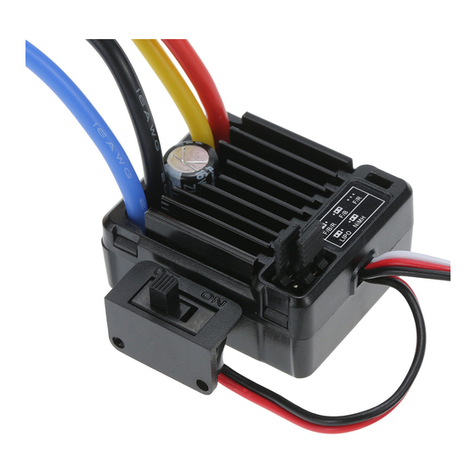
tws
tws WP1060RTR instruction manual
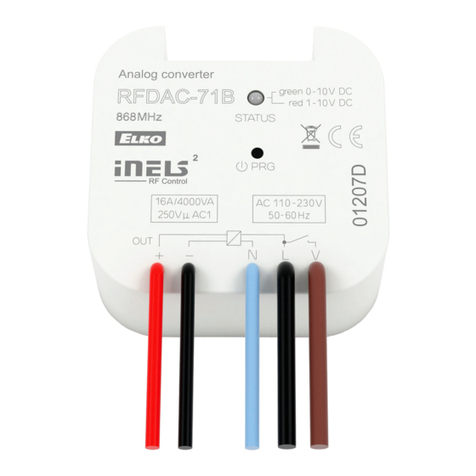
elco
elco iNELS RFDAC-71B quick start guide
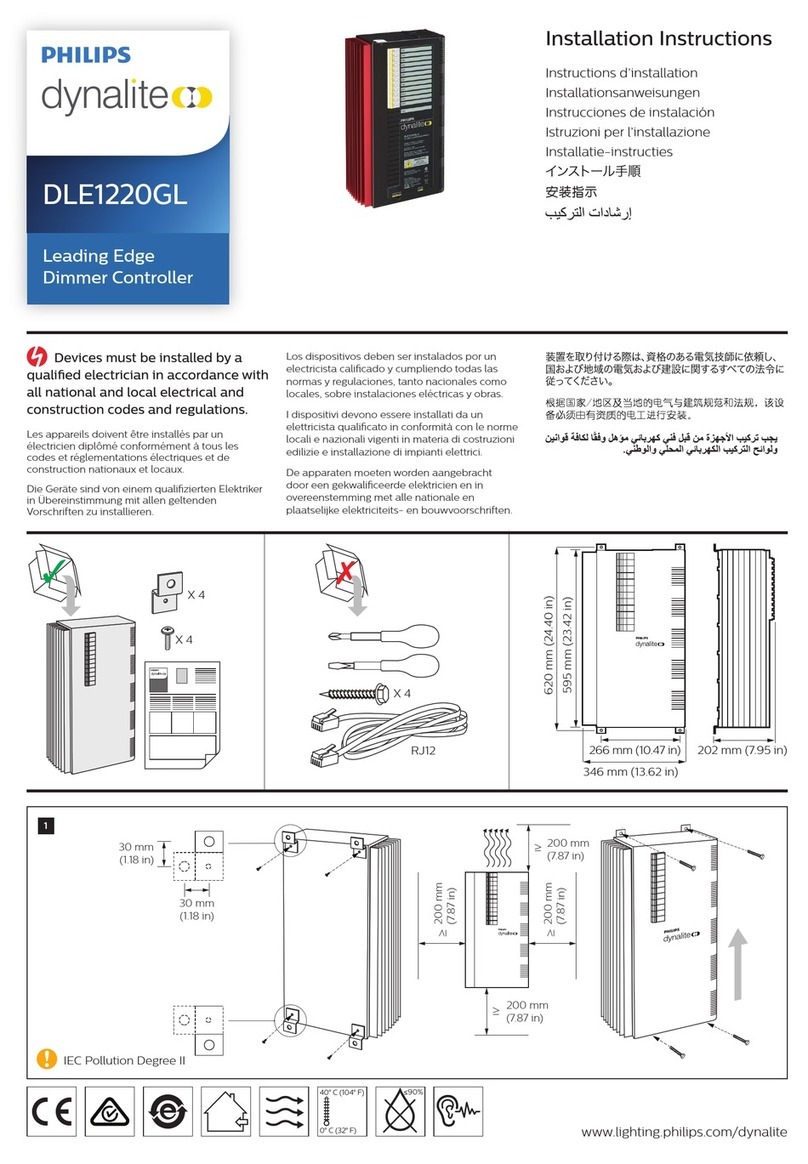
Philips
Philips Dynalite DLE1220GL installation instructions
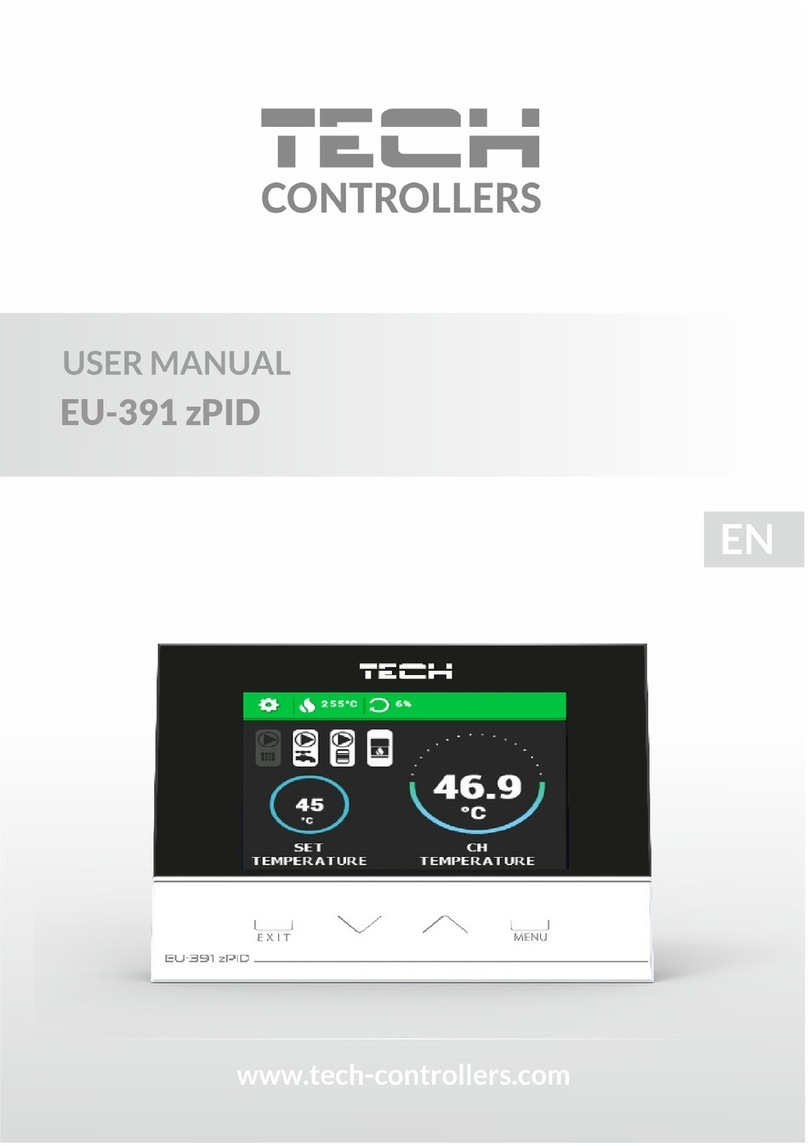
Tech Controllers
Tech Controllers EU-391 zPID user manual
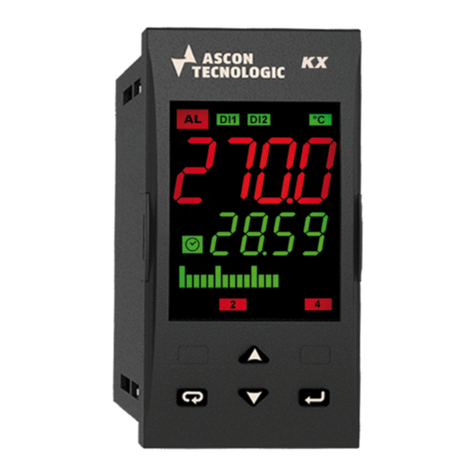
Ascon tecnologic
Ascon tecnologic K 5P Series Engineering manual
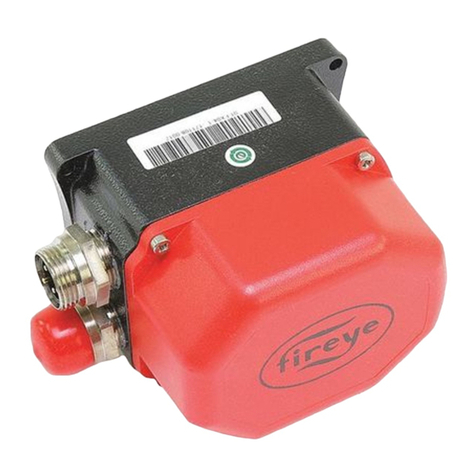
Fireye
Fireye FX Series Installation and Wiring
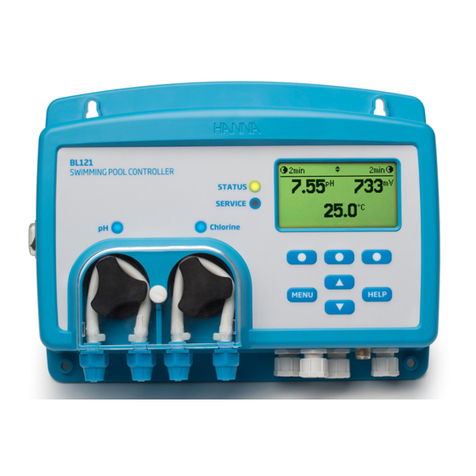
Hanna Instruments
Hanna Instruments BL120 instruction manual

Fireye
Fireye SB Series manual
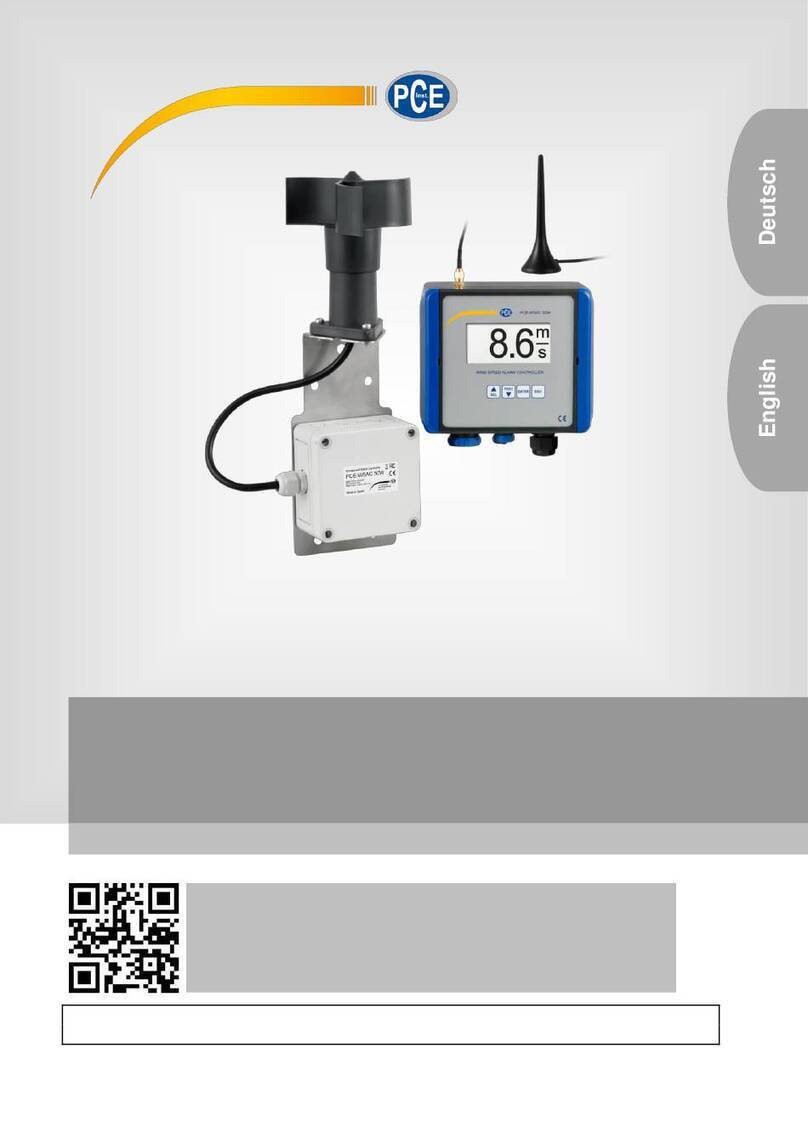
PCE Health and Fitness
PCE Health and Fitness PCE-WSAC 50W 24-ICA user manual
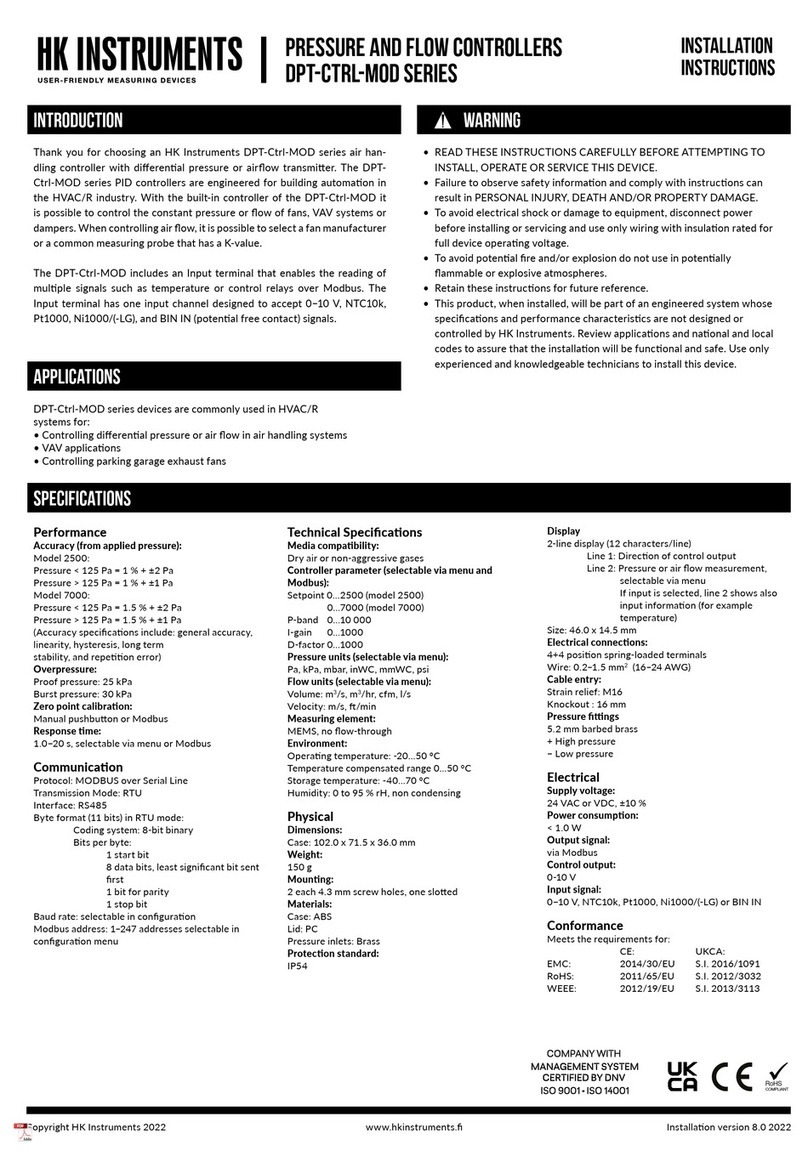
HK Instruments
HK Instruments DPT-Ctrl-MOD Series installation instructions
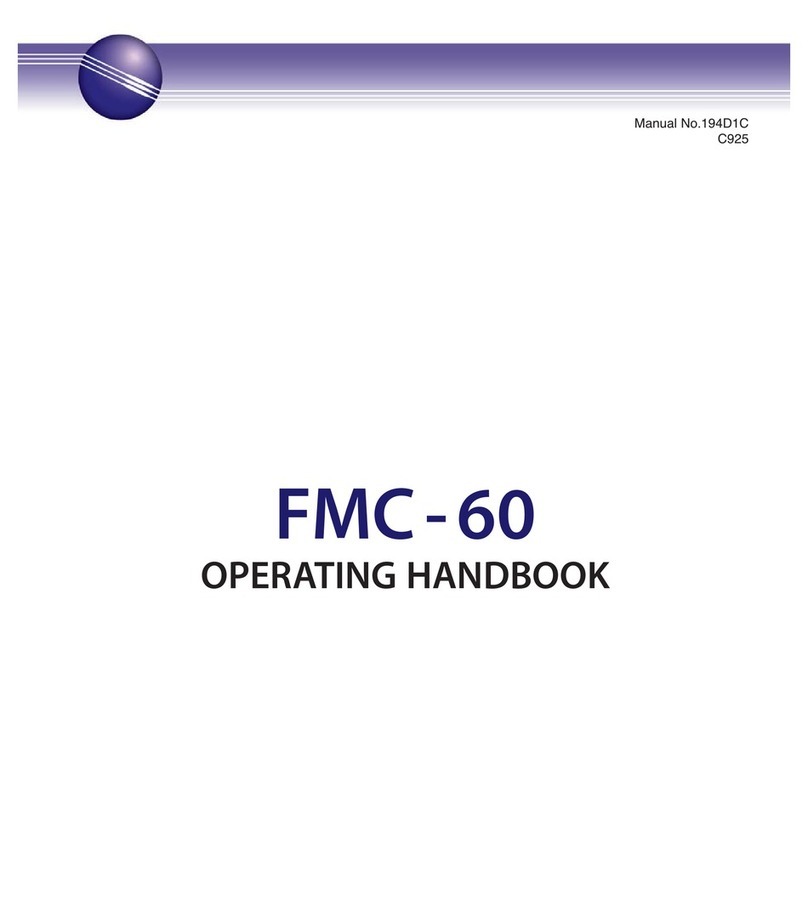
Rae
Rae FMC-60 Operating handbook

Hall Research Technologies
Hall Research Technologies HR-1P operating instructions
